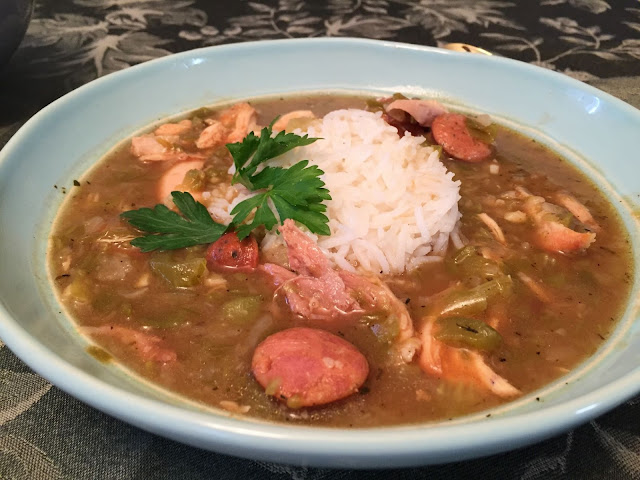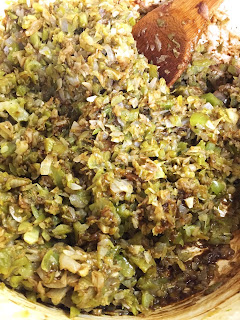Long before ever visiting Louisiana, and later actually living there over the Y2K times, I had heard of Gumbo, as well as Etoufee, Jambalaya and a lot of other dishes, not all of which I really associated with Louisiana. Red beans and rice I'd had in Guatemala as a very young newlywed expat. maybe these were not the Louisiana-spiced version, but the concept was there. Boudin rouge or boudin noir are a sausage made with blood as part or most of its ingredients, but I had eaten those in Guatemala as well, under the name Moronga or Morcilla. Not a banana fan at any time, Bananas Foster never held any interest whatsoever. And long, long before ever learning that bread pudding was pretty much Louisiana's state dessert (according to me, anyway, as it was found in every single restaurant), I had been making and loving bread pudding.
When it came to hearing about Gumbo, I heard about okra as an ingredient, and I am absolutely not an okra fan. Thus, Gumbo held no interest. I like tomatoes, tomato sauces, spaghetti sauces, but there are times I just cannot abide them. At least my stomach seems to completely rebel at times, and then sometimes not. Etoufee, mainly tomato-ey red in color, was not high on a list of things I wanted to try.
 |
| Chicken and Andouille Gumbo |
And then, we moved to Louisiana. Just north of Lake Ponchartrain, there were an amazing assortment of the best eating establishments all grouped so closely near to one another that you could barely toss a stone without hitting one, and we frequented them, almost all, in a constant rotation. My husband will not touch seafood, and not even fish. This is a mental allergy mind you, not a physical one. But as Louisiana cuisine is really all about fish and seafood, crawfish being absolutely huge there, there were many restaurants that had no meat on the menu, and some with a whole lot of truly stellar gourmet seafood dishes available, and with one lone hamburger plate on the menu, generally served with coleslaw (which my husband will not eat) and fries. They truly are not catering to the meat lover diet.
Exploring Gumbo Flavors
As we began exploring food in our new home area after we moved there, I was excited to taste this Gumbo I had heard and read about. I was willing to overlook okra, if the dish was good enough. And I had a couple samplings that were passable, for sure. But it was down in New Orleans proper, that I first had a small bowl of File Gumbo. Being a complete neophyte in the Gumbo world, I had asked the waitress what was the difference. she explained that Okra Gumbo used the okra as a slight thickening agent, whereas File Gumbo used File powder as it's slight thickening agent. Obviously okra has its own flavors as well, as does file powder, but I wasn't aware of that, then.
➤File powder is nothing more than the powdered leaf of sassafras. It is generally
 |
| File Powder |
On tasting the little bowl of File Gumbo, I was suddenly aware that this was amazingly good! Oh my, was it good! And then I went on a search. In each and every restaurant, I tried at least a small bowl or cup of Gumbo, just to see the range of flavors, and just how good, good can be.
While living there, I never even attempted to make Gumbo. More often than not, the Gumbo in restaurants contained crawfish or shrimp. At the time I still wasn't aware of why I was swelling so much all the time, so I blithely ate my way through crawfish, shrimp, crab, blue crab, lobster and a lot of other shellfish. Now, sadly, I have long been aware of my intolerance for those most wonderful foods. Sigh.
Making Roux
Moving away from Louisiana, as all good things must end one day, I longed for Gumbo. As I set about learning what made a good Gumbo, I learned about roux. While I had made roux plenty of times, in preparation for a gravy, those were always a very blond roux, just cooked enough for the raw flour taste to be gone, but not for color. In Louisiana, there is ROUX. Pronounced, "ROO." And this is one not to be messed with. Every young girl must learn the way to make a proper roux, or you will not ever attain a proper gumbo. And this roux must be cooked until "mahogany colored." This requires constant attention to the pot, or the roux will burn. This disaster cannot be repaired, and the only solution is to begin again. This process of cooking oil and flour to a mahogany color can take 15 minutes or it can take an hour, completely dependent on the skill and ease of the one making it. If unskilled, as I was the first time, it took an hour over medium or medium low heat. Over a higher heat, and a lot of quick stirring, it can be accomplished in much less time, but without this very dark roux as a base, the gumbo will not be right.
 |
| Holy Trinity added to Roux |
The next important thing to know is that many, if not most, dishes in Louisiana are based on the flavors of the 'holy trinity, a phrase coined by chef Paul Prudhomme. This trinity is a combination, in equal parts, of chopped onion, green pepper and celery. These should be prepped and ready, as they are the first addition to the Gumbo pot, once the roux is ready.
Andouille sausage, pronounced ahn-DOO-ee, in Louisiana, is generally very highly spiced, with a strong chili kick. For the unwary, this can be a shock. The Andouille found in other areas of the country is but a poor relative, in comparison. I've used Aidell's brand, as I can tolerate the salt levels, though it is not spicy hot.
Chicken and Andouille Gumbo
Serves 8 to 10 |
| Chicken and Andouille Gumbo |
½ cup all-purpose flour
2 tablespoons cooking oil
2 green peppers, chopped
6 stalks celery, chopped
3 cloves garlic
1 whole chicken, cut up
2 - 4 Andouille sausages, sliced
1 teaspoon dried thyme leaves
¾ teaspoon dried oregano flakes
¾ teaspoons dried basil leaves
2 bay leaves
½ teaspoon ancho powder or cayenne
6 cups water or stock
Salt & pepper, to taste
File Powder, for serving
MAKE ROUX: In a heavy soup pot or Dutch oven, melt the shortening or oil over medium heat. Add in the flour and stir continually with a wire whisk until the mixture becomes a deep mahogany brown. This can take from 10 minutes to half hour, depending on your heat setting. Do not scorch the roux or you will need to begin again. Set aside, off the heat.
ASSEMBLE GUMBO: In a large skillet, heat the 2 tablespoons of oil and sauté the onions, green pepper, celery and garlic until softened, about 10 minutes. Add to the pot with the roux. Dry the chicken pieces and brown them on all sides in the skillet, then remove them to the pot along with the sliced Andouille, all the spices, chili powder and water or stock. Add in about 1 teaspoon of salt, to start, and some freshly grated black pepper. Stir well, then cover and cook on very low heat for an hour, or until the chicken is very tender. Once the gumbo has cooked, check for seasoning and adjust as needed. Leave chicken on the bone, or remove the skin and bones, if preferred, returning the chicken meat to the pot. Serve with a scoop of rice. Serve File Powder on the side. Use 1 to 3 teaspoons per serving, to taste.


No comments:
Post a Comment